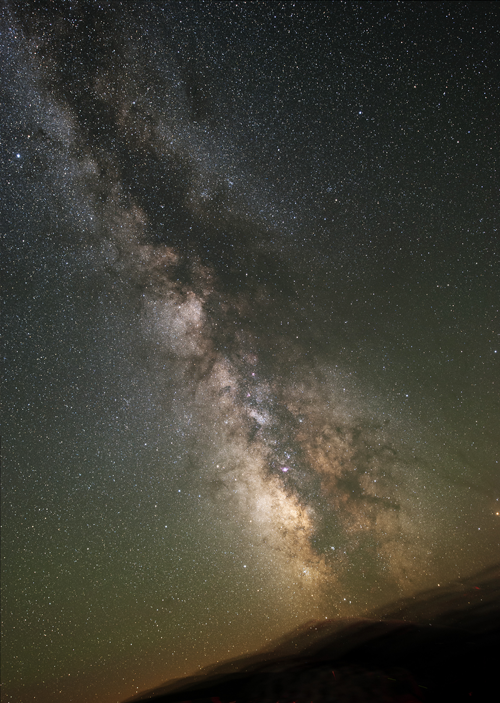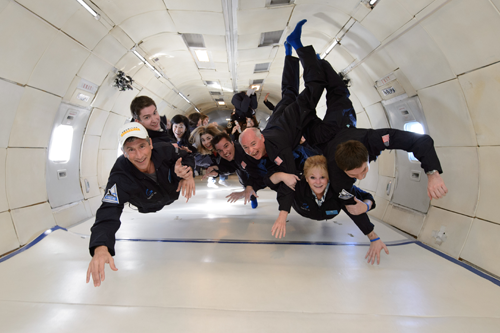Why Go to Space?: A Google Hangout for Galactic Answers
A Google hangout this week gives students and teachers a chance to find out more about space exploration and to talk with astronauts and leaders from Virgin Galactic about some of the many, many reasons "why" space science matters.

Do you look up at the night sky and see, simply, the stars, the imaginary outlines that link stars to form constellations, the blinking lights of planes as they pass, bright speck of Venus, the shifting clouds on the moon making the face in the moon that appears in children's stories? Do you look up, and see the brave new frontier heralded, traveled, explored, and inhabited in popular television series like "Star Trek," "Dr. Who," and "Firefly"? Or maybe you look up and see something in between.
Maybe you hope to be an astronaut, or maybe you are just curious about what potential exists beyond our atmosphere. Maybe when you look at a photo from the Hubble Space Telescope, you realize that every one of the dots you see, really, is a galaxy or a cluster of galaxies. Maybe you contemplate that reality, and your head spins, just a bit, and you think, too, of the Milky Way and that, in fact, our spinning-armed galaxy is just a dot in the vastness of space. Maybe you are fascinated by photos from the International Space Station that show astronauts looking back at Earth, a completely different perspective on our planet.
In a TEDx talk in January, Will Pomerantz, a graduate of the International Space University and Vice President of Special Projects for Virgin Galactic, talked about space and the "why" of space exploration. "From Yuri Gagarin in April 1961 until today, 542 human beings have been in outer space," said Will. "And I can guarantee you that every one of those 542, plus all of the hard working men and women who have helped put them up there, all the people who work on the great robots like Mars Curiosity, like the Hubble Space Telescope, every single one of them has been asked at some point by a friend or by a loved one—'Why? Why is it worth it? Why do we go to outer space?'"
Maybe you have similar questions, questions about the time and money involved in space exploration, questions about what we can learn, as a society and as a planet, by exploring space, questions about how space exploration can make a difference in life on Earth.
Space Education, Hangout Style
Virgin Galactic, a sponsor of the 2014 Google Science Fair, is all set to answer questions about space exploration in an out-of-this-world Google hangout this week titled "Why Go to Space." Gavin Ovsak, a former Google Science Fair finalist, will lead the hangout and pass along questions submitted by the audience to Sam Branson and Will Pomerantz. Sam, already known for his adventures in the Arctic, and son of Virgin founder Richard Branson, is training to be part of Virgin Galactic's first commercial spaceflight scheduled for later this year. Together, Will and Sam will join forces at the hangout to answer questions about space travel and give you their perspective on "why" we should consider going to space—why we should consider continued space exploration important.
As Will puts it, there are an infinite number of possible answers to the question. "I don't think you can give the top 10 reasons why we go to space, because, after all, there are 7 billion of us" and who "knows how many planets and stars and reasons out there."
Drop by this week's hangout to hear what questions others have about space, to ask your own questions, to hear Sam and Will as they talk about some of the reasons "why," and to think about your own answer to the question: "Why go to space?"
The hangout will take place on February 28, 2014 at 18:00-18:30 GMT (1PM EST/10AM PST). To join the hangout, visit http://goo.gl/6ZpZMG.
Read more about this week's Virgin Galactic hangout in this article on the Virgin Galactic site.
Making Connections
Students interested in space exploration can explore relevant ideas and concepts in engaging astronomy science projects like these:
- Dirty Snowballs: How a Comet's Size Affects How Fast It Melts: Comets are big lumps of rocks, ice, and frozen gases that orbit the Sun. The glowing tail behind a comet's nucleus is the visible sign that a comet is melting. Do big comets melt faster than small ones? In this science project, students model comets using ice forms and a hair dryer to explore the relationship between a comet's size and the rate of melting.
- Catching Stardust: Astronomers design and build satellites to orbit a planet, moon, or comet and collect space particles, or "stardust." How many space particles are collected this way, and what variables increase or decrease a satellite's effectiveness in gathering stardust? In this science project, students build their own mini satellite and use it to collect pretend stellar debris. What difference does the orbit distance of the satellite from the object being observed make in terms of what is collected?
- The Milky Way and Beyond: Globular Clusters: The color of a globular cluster gives clues about both the age and the contents of the cluster. When you look at the colors of the globular clusters in our galaxy and compare them to the colors of clusters in another galaxy, what kinds of conclusions might you draw?
- Craters and Meteorites: The craters on the surface of the moon may resemble the holes in Swiss cheese, but what accounts for the differences in crater size? In this science project, even the youngest of students get hands-on exploring how impact craters are formed and why some are deep, some are shallow, and some are bigger than others. Does the size of a crater depend upon the size of the meteorite?
- Asteroid Mining: Gold Rush in Space?: Could asteroid mining be the space equivalent of gold or coal mining? In this science project, students analyze data from the NASA's Jet Propulsion Laboratory Small-Body Database to develop their own business plan for a hypothetical asteroid mining company. Which asteroids should you target for an early asteroid mining mission?
- NASA Asteroid Database: What Can You Learn About Our Solar System?: In addition to the well-known planets, moon, and sun, our solar system is filled with millions of asteroids. Agencies like NASA track asteroids, partly because of the risk of an asteroid collision with Earth. But asteroid data may also provide information about the history of our solar system and our future in space. In this science project, students explore NASA's Jet Propulsion Laboratory Small-Body Database and learn to work with "big data" as well as investigate what this data can tell us about our solar system.
- The Measure of Mercury: Analyzing Impact Craters on the Innermost Planet: NASA spacecraft gather data that scientists then use to further explore and understand space. In this science project, students use data collected from NASA's MESSENGER mission to learn more about impact craters on Mercury. Using NASA data, students investigate the relationship between the depth and diameter of Mercury's impact craters.

Categories:
You Might Also Enjoy These Related Posts:
- Plastics and Earth Day - Science Projects
- Arduino Science Projects and Physical Computing
- 10+ Robotics Projects with the BlueBot Kit
- 5 STEM Activities with Marshmallow Peeps
- March Madness Basketball Science Projects: Sports Science Experiments
- Women in STEM! More than 60 Scientists and Engineers for Women's History Month
- Explore Artificial Intelligence and Machine Learning with Student AI Projects
- 10 Reasons to Do the Rubber Band Car Engineering Challenge









